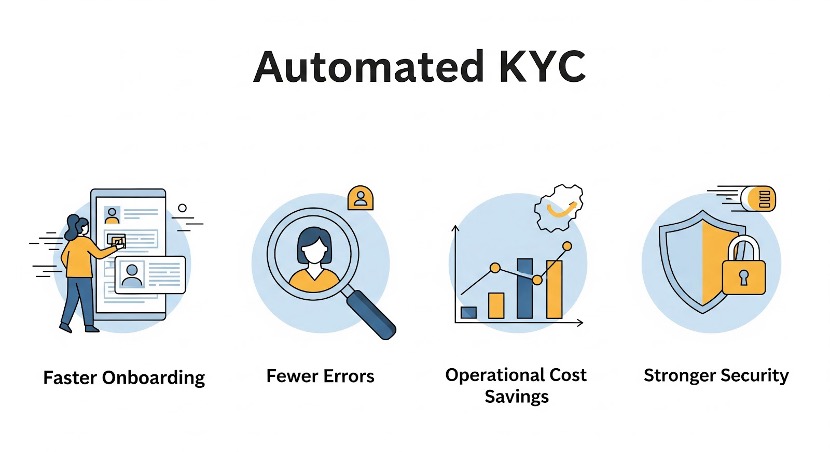Automated KYC Solutions: The Future of Compliance for Asset Management Firms
Last Revised: August 9, 2025At a Glance
In 2025, automated KYC solutions help asset management firms reduce onboarding times, cut compliance costs, and lower regulatory risk. Unlike manual KYC, which is slow and error-prone, automation streamlines processes and improves investor experience.
For years, asset management firms have relied on outdated, paper-heavy KYC systems. These manual processes delay onboarding, increase compliance risk, and drive up operational costs. In today’s digital-first world, agility and security are non-negotiable.
In this post, we explore the true cost of manual KYC and show why automated solutions are helping firms turn compliance from a liability into a competitive advantage.
What Are the Hidden Costs of Manual KYC?
Manual KYC processes are resource-intensive, error-prone, and slow, leading to higher compliance costs and lost business opportunities for asset managers. This makes the need for automation clearer than ever.
Manual KYC is inefficient, slow, and error-prone — and these issues translate directly into lost time, increased costs, and missed opportunities.
Key pain points:
- Labor Intensive Workflows
Manual processes require significant human effort. Compliance teams spend hours verifying documents, cross-checking data, and chasing email threads — all of which drive up labor costs and distract from higher-value tasks.
- High Error Rates
Manual data entry is inherently risky. Human errors can lead to compliance breaches, regulatory fines, and reputational harm. Even a single oversight may result in serious consequences. - Delayed Onboarding
Speed is critical in today’s competitive market. Manual KYC can stretch onboarding timelines from days to weeks and even months. A recent global study found that nearly 48% of institutions lost potential clients due to onboarding delays caused by manual KYC processes. - Reputation Risk
A clunky, outdated KYC process sends the wrong message. When investors encounter friction from day one, it damages trust before any capital is even deployed.
These hidden costs add up quickly, draining resources and hindering growth. The time has come to reimagine KYC as a streamlined, automated process that works for you instead of against you.

Manual KYC: Fatigue, errors. delays, and reputational risk
How Does KYC Automation Solves Manual Inefficiencies?
Automated KYC helps financial institutions improve compliance speed, reduce manual errors, and lower operational costs. With AI-driven tools, firms can onboard investors faster, minimize regulatory risk, and enhance data security.
KYC automation is more than a tech upgrade — it redefines how compliance is done. By replacing manual tasks with AI-powered systems, financial firms gain speed, accuracy, and better investor experiences.
Key benefits of automated KYC:
- Faster Onboarding
Automated systems can verify documents and process data within hours, not days. This helps onboard investors quickly and reduces the risk of losing high-value prospects to competitors.
- Fewer Errors
AI tools minimize human error in data entry and verification. According to Gartner, financial institutions using AI in compliance saw a 50% drop in false positives, lowering the risk of fines and boosting trust.
- Operational Cost Savings
Automation reduces the need for manual labor in repetitive tasks. Compliance teams can focus on strategic work — saving time and money.
- Stronger Security
Automated platforms offer built-in security features such as end-to-end encryption and real-time alerts, helping firms stay compliant with evolving regulations and protect investor data.
By automating the KYC process, firms turn a costly, manual chore into a scalable advantage — one that drives efficiency, reduces risk, and accelerates growth.

The benefits of automated KYC
How Much Is Manual KYC Costing You?
Manual KYC can cost asset managers hundreds of thousands annually in labor, regulatory fines, and lost opportunities. As firms face increasing compliance demands, automation offers a clear path to efficiency and cost control.
Consider a mid-sized investment firm that relies on manual KYC processes. The cumulative cost of labor, errors, and delayed onboarding can easily run into hundreds of thousands of dollars each year. When you factor in lost business from frustrated investors, the financial impact is even greater.
Let’s break it down:
- Labor Costs
According to Avallon, compliance teams lose hours weekly to chasing data, managing submissions, and updating records. If a compliance officer spends 10 extra hours a week on manual data entry, that adds up to hundreds of billable hours annually. Scale that across a team, and the financial impact becomes unsustainable. - Error-Related Fines
Regulatory penalties for non-compliance can reach into the hundreds of millions. Financial institutions have been fined over $100 million for poor customer identification and monitoring practices. Even one mistake can result in serious financial and reputational damage. - Opportunity Costs
Every hour wasted on manual processes is time not spent on growth. Faster onboarding means quicker revenue, better investor experience, and a stronger competitive edge.

How much is manual KYC costing you?
What’s The Real-World Impact On Investor Experience?
Investor experience directly impacts fund success. Automated KYC solutions offer faster, more transparent, and personalized onboarding, helping firms retain high-value investors and build trust from the start.
Investor experience is more than a buzzword — it’s a growth driver. In today’s digital-first market, investors expect a seamless onboarding process. A manual, paper-heavy KYC workflow can make or break the relationship from the very start.
Consider this scenario:
A high-value investor is eager to commit capital, but the KYC process takes weeks. Frustrated by repeated document requests and delays, they walk away. That’s not just a lost deal; it’s a missed opportunity to build trust and loyalty.
In contrast, an automated KYC process offers:
- Speed and Efficiency
Investors are onboarded quickly, keeping momentum high and preventing drop-offs during compliance.
- Clarity and Transparency
Real-time updates and user-friendly dashboards give investors full visibility, building trust early on.
- Personalization
Automated platforms can tailor onboarding journeys to individual preferences, making investors feel seen and valued from day one.
When firms prioritize investor experience with automated KYC, they gain more than efficiency — they build long-term, profitable relationships based on trust and transparency.

Frictionless KYC, Happy Investors
The Future is Now: What Can Asset Managers Do to Stay Ahead?
To stay competitive, asset managers must shift from manual KYC to automation. By adopting modern tools, tracking key performance metrics, and fostering innovation, firms can boost compliance efficiency and improve investor satisfaction.
In a fast-moving industry, the shift to automation isn’t optional — it’s strategic. Asset managers who act now gain a competitive edge by accelerating compliance, improving accuracy, and enhancing investor experience.
Here are 4 important steps to start embracing automation:
- Adopt a Forward-Thinking Mindset
Recognize that manual workflows are no longer viable. Treat automation as a business priority that shapes your firm’s future positioning.
- Invest in the Right Technology
Choose platforms that automate document verification, data extraction, and compliance checks; while also offering security, scalability, and integration with your existing tools.
- Foster a Culture of Continuous Improvement
Empower your compliance team to innovate. Encourage regular training, experimentation, and open feedback loops to improve efficiency over time.
- Measure What Matters
Track KPIs like onboarding time, error rates, false positives, and investor satisfaction. Use these insights to optimize and refine your processes continuously.
By committing to KYC automation today, VCs, PE firms, and hedge funds can eliminate inefficiencies, reduce risk, and scale faster in an increasingly competitive market.
The Bottom Line
The cost of manual KYC is steep; and it’s a cost that no modern asset manager can afford. In an industry where speed, security, and investor experience are paramount, the old ways of doing things simply don’t cut it anymore.
Automation offers a clear path forward: faster onboarding, lower costs, reduced error rates, and a vastly improved investor experience. For fund managers, this isn’t just about keeping up with the times – it’s about gaining a competitive edge that can drive long-term success.
Why Blackbird?
Blackbird offers an AI-first solution tailored to private market firms, including automated KYC, AML, and Due Diligence in one seamless platform. Built-in automation means faster onboarding and stronger compliance, without the added headcount.
Want to see it in action? Book a demo with our team.
For more insights (or fun KYC memes), follow us on LinkedIn.
About the Author
Linoy Doron is a Content Strategist at Blackbird, where she translates complex fintech and compliance topics into clear, actionable insights. With a strong background in technology, SaaS, and UX, she crafts narratives that connect product value to the real needs of asset managers in the private markets.